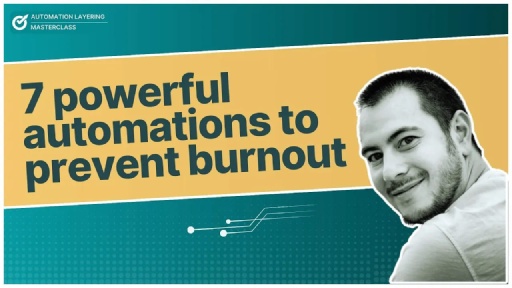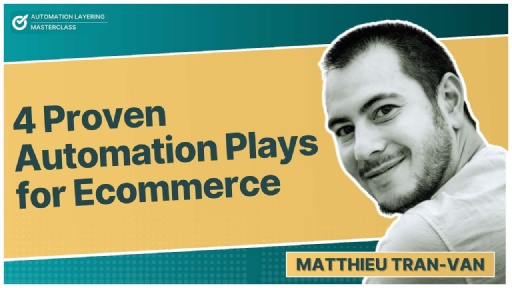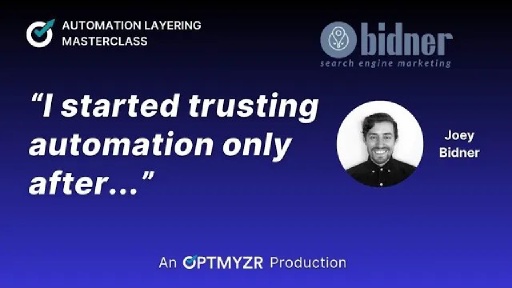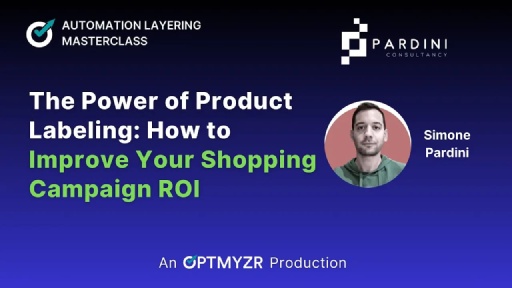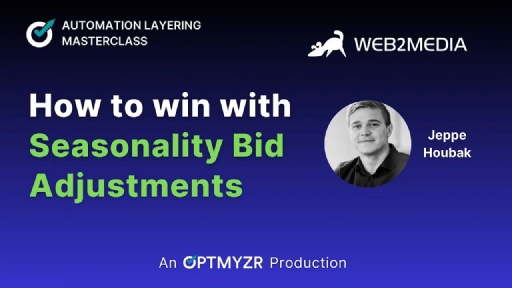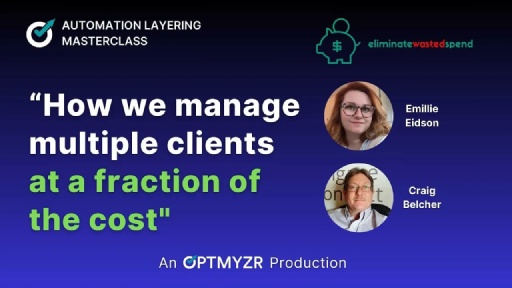
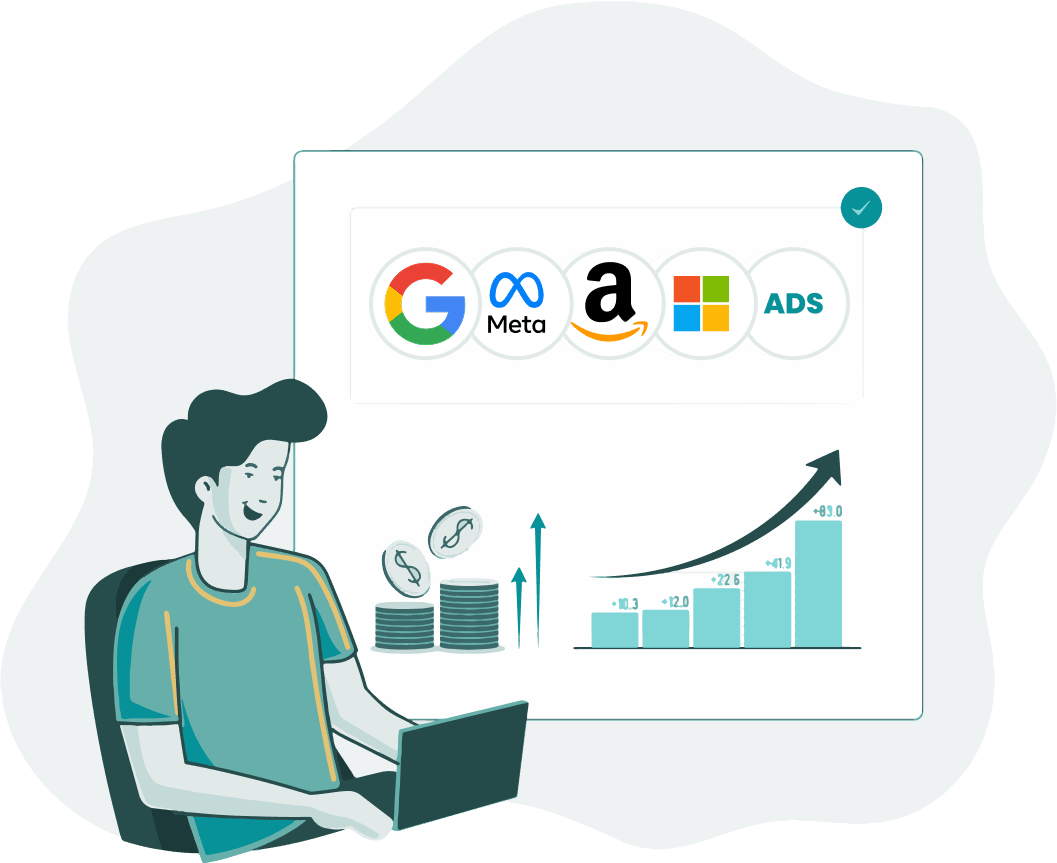
Episode Description
In the face of increasing competition and rising costs, advertisers need to switch to data-driven bidding strategies. One such approach that is quickly gaining traction is value-based bidding— a strategic approach that prioritizes high-value conversions over volume.
In this episode of the Automation Layering Masterclass, our CEO and Co-Founder, Frederick Vallaeys speaks with Taylor Mathauer and Will Gray from WebMechanix to discuss how they successfully implemented value-based bidding to drive 30% higher-quality leads. They’ll share what worked, challenges they overcame, and actionable insights for advertisers looking to refine their bidding strategies.
You’ll learn more about:
- The power of value-based bidding
- Identifying the right signals for proper conversion tracking
- The role of first-party data in improving results
- The challenges with value-based bidding
Episode Takeaways
Value-based bidding in combination with high-quality first-party data can be a useful tool in driving meaningful business outcomes. It can help advertisers optimize ad spend and target high-value customers who are most likely to convert.
Fred, Will, and Taylor discuss why conversion values should never be a one-size-fits-all and explore how you can refine bidding strategies and improve campaign performance.
1. The power of value-based bidding
Value-based bidding is a type of strategy where the focus is on maximizing business impact by focusing on high-value conversions. Instead of simply aiming to get the cheapest clicks or leads, value-based bidding prioritizes actions that actually generate more revenue or business impact.
While it does require proper conversion tracking, patience, and multiple iterations to get it right, you benefit from higher ROI since ad spend is directed toward the most profitable conversions.
Taylor demonstrates this with the example of a client in the addiction treatment space. In this particular case, the client used both phone calls and form fills as lead channels. However, they noticed that people who called had a significantly higher conversion rate to actual treatment (the key business goal) as compared to form fills.
Before value-based bidding, their conversion mix was heavily skewed towards form fills. Now, this was problematic because Google’s algorithm treated both conversion types as equally valuable, optimizing for total conversions rather than the most valuable ones.
WebMechanix identified this and drew up a strategy where they implemented value-based bidding by assigning a slightly higher value to calls as compared to form fills. Over time, they gradually increased the value gap, ultimately telling Google which conversion type was more valuable. This resulted in a dramatic shift in the conversion mix.
“We did see the ratio of calls to form fills move up from pre-value-based bidding. Earlier, it was about 42% calls and about 57-58% forms. Post value-based bidding, we saw our calls were up to 70% while 30% of our leads were coming from forms. So really sort of shifted that ratio to where we were successful and able to see those calls being that primary driver of those leads,” shared Taylor.
2. Identifying the right signals for conversion tracking
Not all leads are created equal, and if you’re optimizing for the wrong actions, you may end up wasting your ad spend. This is why it is important to track the right conversion signals and assign value to high-impact conversion events.
Taylor and Will took a strategic approach where they:
- Properly classified high-value and low-value conversions to help Google’s algorithm optimize towards actions that actually matter
- Narrowed down which conversion types led to better business outcomes rather than tracking overall conversion numbers
“They found that they prioritized calls over form fills just as it was easier to keep people on the phones and continue that process to getting them into treatment versus forms where they had much lower close rates,” shared Taylor.
- Tracked how initial conversions translated to qualified leads and sales to validate the quality of the conversion signals
- Made sure there was sufficient conversion volume to help the machine learning algorithm effectively optimize towards the right goals
- Identified interim conversion points for businesses with longer sales cycles
3. The role of first-party data in improving results
When optimizing for real business value, first-party data is crucial in accurately assigning values to conversion actions. For example, WebMechanix tracked the close rates in their client’s system to find out that calls were much more valuable than form fills. They used this information to assign more accurate relative values to each conversion type rather than treating all conversions equally.
“We set calls at a value of a thousand, and then we had forms set at a value of a hundred. So sort of like a ten to one ratio between the two since we were really trying to prioritize those calls and the outcome was great,” said Taylor
This highlights the power of feeding quality data back into Google’s algorithm. By providing insights into which conversions actually led to customers, the system can better identify behavioral patterns and signals associated with high-value conversions, ultimately enabling more precise targeting.
4. The challenges of implementing value-based bidding
Although value-based bidding is a great strategy to drive meaningful conversions, it does come with its own challenges.
For one, you would need to have sufficient conversion volume for Google’s machine learning algorithm to properly learn which users are likely to convert. Without substantial data, the algorithm cannot make effective bidding decisions.
Another important thing to note is that there is an unavoidable adjustment period when you first implement value-based bidding. You might notice that initial performance appears worse before it starts to get better. This is precisely why the WebMechanix team gradually adjusted their value settings over multiple iterations rather than setting too high of a value right off the bat.
***“*It definitely was an iterative process. So, in the beginning, we started gradually because I also wanted to be mindful. We wanted there to be gradual changes to see the shifts truly play out. It was sort of like that wait and see game where I didn’t want to make too many changes to the bid strategy, but also wanted to start to amp it up as I started to see the results coming through,” shared Taylor
Another key aspect of value-based bidding is setting the right expectations with your client from the beginning. When you switch to value-based bidding, it is common to see a drop in the overall volume of leads or form fills along with an increase in the cost per acquisition. This requires extensive upfront communication to reset client expectations from volume-focused metrics to quality-focused outcomes.
“ And this takes a lot of communication upfront with the client before you even decide to switch over to a value-based bidding approach. It’s like, hey, we might see overall volume come down for like leads or form fills but that’s not really the goal of this. The goal of this is to improve lead quality that will translate into more revenue, likely the conversions that we’re now missing out on weren’t gonna turn into sales for you anyways.” Will says.
Tools & Resources
- Value-Based Bidding: What Is It, Best Practices & Pitfalls
- How to make value-based bidding work for you
- Take Your Ad Spend Further with Value-Based Bidding in Optmyzr
- Explore Traffic Segments
- How to make rules in Rule Engine work for you
Episode Transcript
Frederick Vallaeys: Hello, my name is Fred Vallaeys. I’m the co-founder and CEO at Optmyzr. I’m also the host for Automation Layering Masterclass, the class that teaches you how to get better results from modern PPC management.
Now one of the problems in modern PPC management is that a lot depends on automations provided by the ad engines like Google. There’s a lot of machine learning and a lot of artificial intelligence that does things to these campaigns. But what we have historically seen is that if you add humans to the mix, they can actually make the machines do better. And that makes sense because you as the human, you already know things about your client, you know things about the business.
If you could just inform the machines about those things and not let them be all generic, you’d actually get better results. But then the question becomes, is this going to be tedious? Is this going to be time consuming for me as a human to oversee these massively complicated systems from Google that do all this sophisticated AI and machine learning?
Well, the good news is it doesn’t have to be, and that’s what automation layering is all about. It’s about taking your human strategies and having your own set of tools and tactics to make sure that those AI systems from the ad engines are working towards your goals. And one of the best examples of this is what we’re gonna share today, Will and Taylor from WebMechanix used value-based bidding to drive better quality results for one of their clients.
Today they will share with us how they did that, what problems they were facing, and hopefully you will learn how you can deploy value-based bidding and automation layering for your advertising campaigns. So with that, let’s go and meet our guests for today.
All right, Will and Taylor, welcome to the show. Thank you for being part of our first automation layering masterclass.
Taylor Mathauer: Of course. Thanks for having us.
Will Gray: Yeah. Glad to be here.
Frederick Vallaeys: All right. So, Taylor, you’re in the middle there so let’s start with you. Tell us a little bit about what you do. Yeah, so I’ve worn a few hats here, but found my stride at WebMechanix doing paid search and paid social.
For these purposes, I sort of transitioned into working with teams and sort of helping strategy with those specific channels. But yeah, working alongside Will is one of them.
Frederick Vallaeys: Great. And then that ties up real very nicely. Will, what do you do?
Will Gray: Yeah, so I’m a paid search director here at Web Mechanics.
I focus a lot on our high spending paid search accounts, directly managing a lot of those, and then working across teams to help improve the performance on paid search, where we might be kind of missing the mark at the moment, and then helping them get to where we need them to go.
Frederick Vallaeys: Yeah, that’s always the big thing, right?
We’re getting them where they need to go and it’s never the same because PPC keeps evolving so quickly. So you know you’ve worked with a client and obviously there was a problem. They came to you for a reason. Can you explain a little bit what they were facing, what issues they were having?
Taylor Mathauer: Yeah, so my client in particular, they are in the addiction space and so the name of their game is really lead volume. So we were facing this challenge where we were generating leads, but quality was an issue there. They found that they prioritized calls over form fills just as it was easier to keep people on the phones and continue that process to getting them into treatment versus forms where they had much lower close rates.
So sort of the challenge where they were at is they didn’t necessarily want to say, let’s deprioritize forms, make that a secondary action. They wanted to continue to have both running, but give that priority to if a user is going to like, prioritize those phone calls essentially was their, their challenge that they posed to us is we want better quality, more calls, but not necessarily getting rid of forms.
Frederick Vallaeys: So kind of the problem that when you run Google Ads, you’re basically going after conversions and a cost per acquisition model, or a return on ad spend model. But the problem is that a lot of advertisers don’t exactly quantify those conversions the right way. And so you could get lots of cheap conversions, but they might be really low quality and “conversion” is someone who fills out the form, but like, nobody cares about form fills, right? We all care about who ends up paying at the end of the process and it sounds like this is what it was about.
So the calls were more likely to lead to that end stage of a conversion, and that’s what they wanted to get more of then. Is that right?
Taylor Mathauer: Yep, that’s exactly right. Yeah. Calls, they had a much higher success rate with closing, so really just trying to jack up the amount of calls that we were getting from our campaigns.
Frederick Vallaeys: An then you kinda alluded to something that’s already a little bit more complicated here, but primary and secondary conversion action. Will, do you wanna, maybe we’ll bring you into the conversation here and then tell us a little bit about what that’s all about.
Will Gray: Yeah, so the primary conversion actions are essentially what your campaigns are gonna be optimizing towards.
So in your conversions tab, if you go under the settings and then look in your conversions, you can see some listed as primary or secondary. Secondary essentially means that they’re still being counted in your side of your account. But your conversions, they’re not being counted in your conversion columns, so we’re not actually optimizing towards those secondary ones.
It is useful to still have some of that stuff in there just so you can look at your all conversions and see, you know what secondary conversions are still converting. So let’s say like we are optimizing towards form fills, but we’re posting back data and we just don’t have enough of it to. Set that as a primary conversion action, whether that be MQL or SQL, we still wanna track the quality of our leads, but we won’t wanna actually start optimizing towards that lower funnel conversion action.
So we can set that as secondary and then still see like, okay, this campaign had 50 form fills, but only like two MQLs, maybe we need to adjust something on the front end, whether that be keyword search terms, location targeting or something like that to start driving more MQLS from those leads that we’re actually driving.
Frederick Vallaeys: Right. And that seems like a pretty common scenario in high value lead gen like the space that this client is working in is you get a fairly low volume of actual deals closed on a monthly basis, and then that’s the game in PPC, right? When do we have enough volume to give something to the machine learning system from Google which manages the bids for you.
Because if you give them two conversions per month, well you know, it’s not gonna learn very fast. It’s not gonna have a lot of data to steer the ship, so it’s really not gonna be optimizing that much. So how do you get to a place where you have enough conversions, say like maybe 30 a month so that you can actually make decisions, but then also tie that back to what you ultimately care about.
So that’s kind of the name of the game. And in the past I’ve heard people talk about micro and macro conversions. Nowadays we’re talking about primary and secondary conversion actions. And before that, I think in the Google system, it was called quote unquote, include in conversions, was what that setting was called.
But so very interesting how you’re using that primary conversion action to drive the machine. And by the way, Will this question is for you, but you said this helps decide what optimizations to do. We’re talking about bidding, I think smart bidding, but are we talking about more than that in terms of like, what are we deciding based on primary conversion actions?
Will Gray: Yeah, so I still think it’s like useful to have in there. Let’s say like you have a keyword that’s driving a ton of conversions or something like that, and over the last like 30 days, 60 days, it’s driven like a hundred conversions but no actual MQLs.
Even though the volume’s still low, that can still be a good signal for us. Like, okay, this is driving a ton of conversions, no MQLs, maybe we should pause this and spend money elsewhere where we have room to grow, where we’ve actually gotten a few MQLs. Even though it’s lower volume, it can still point us in the right direction.
Frederick Vallaeys: Right. So some budget decisions, it sounds like, could be based on this. If you have a limited budget, you allocate primarily to where most of the MQL are coming.
Will Gray: Yeah, I think budget, landing page, ads, really anything that you can test. Like I don’t see why you can’t use this data to at least point you or as a guiding light to the right decision. Like yes, we might not have the volume to actually optimize towards it in our bid strategies, but it can give us a sense of what is currently working in the account and what’s not currently working to help us grow revenue.
Frederick Vallaeys: Yeah. And Taylor, what was the outcome of doing some of these, VBB based strategies for that client?
Taylor Mathauer: Yeah, so essentially we set calls at a value of like, I think it was a thousand, and then we had formed set as a value for a hundred. So sort of like a 10 to one ratio between the two. Really trying to prioritize those calls and the outcome was great.
So we had this running on, you know, a four month basis to sort of see the growth and make sure we had enough data to see the impact. We did see the ratio of calls to form fills move from pre value-based bidding. It was about like 42% calls, 57-58% forms. Post value-based bidding we saw our calls were up to 70%. 30% of our leads were coming from forms.
So really sort of shifted that ratio to where we were successful and able to see those calls being that primary driver of those leads. Also, overall, we did see a slight increase in our conversions, which was nice outside of those optimizations, but yeah, really saw the ratio shift to to 70%.
Frederick Vallaeys: So you saw the client getting more of the type of conversion they thought was higher value that would eventually to MQLs.
Taylor Mathauer: Yep, exactly. And you know while we were really happy to be able to sort of like meet the baseline here, like we were able to get more calls coming through, we did see that trickle down as well as far as like their, sort of down funnel metrics are concerned.
So over time, while we were getting. Like we basically saw that we were increasing our value or VOB completes, which essentially are like their MQLs, if you will. So essentially, you know, we were not only seeing in platform, we were meeting, like calls the goal that we had set there, but it was trickling down funnel all just because of that shift there. So it was really successful, sort of twofold and is still a strategy that’s working really well in that account.
Frederick Vallaeys: So, let’s boil that down. So, because I think you also explained what was the solution, how did you fix this problem and get to these great results that you wanted? VBB is basically about if you’re in lead gen, rather than saying we have a straight up cost per acquisition goal, maybe shifting it more to a ROAS goal and starting to define different values for what used to be a singular conversion. And so I think you kind of went there and you said, well, for calls we’re gonna put a thousand dollars conversion value rest for the form fails, we’re gonna put a hundred dollars conversion value.
Now how did you pick these numbers and did these numbers eventually change or did it just work off the bat?
Taylor Mathauer: I wish it just worked off the bat. No, it definitely was iterative. So in the beginning it was, you know, we started gradually ‘cause I also wanted to be mindful where we didn’t just completely throttle our ‘cause, like lead volume overall we didn’t want to see a huge drop.
So we wanted it to sort of be gradual changes to start to see the shifts truly play out. I started with forms being at like a hundred dollars and I think calls I set to like 250, like a smaller split. Didn’t necessarily see a shift happening. After one month shifted that again, moving into the next month up to 500, and then by month four when I started to see that trend going up I’d moved over to a thousand and so that’s sort of, it was like over time waiting to see that that happens I know it’s sort of like that wait and see game where I don’t wanna make too many changes to that bid strategy, but also want to start to amp it up as I started to see the results coming through.
So yeah, definitely was sort of iterative over time as we started to see it either not work enough in the beginning, but then as we started to see that success and sort of lead volume not drop off with that change felt more comfortable laying on the pedal a little bit more.
Will Gray: Yeah, I think this client specifically was like a pretty unique situation because typically like these days when we’re talking about value-based bidding, we’re talking about posting data back from like a CRM and then optimizing towards a lower level funnel action that’s happening within the CRM.
So whether that be like MQL, SQL or eventually sale, this was, hey, we need to tell Google which conversion action we wanna prioritize. So we can’t get rid of these conversion actions ‘cause the client still felt like they’re important, but we want to tell Google, with tROAS as what action we want our users to be taking go out and find more users that are gonna take that action.
So in this case it was calls, so it was kind of just fiddling around with the conversion volumes, like where’s the limit, where we can start getting more calls and I guess a thousand dollars was that limit and then a hundred for the form fills.
Taylor Mathauer: Yeah. Theirs is such a unique case ‘cause yeah, I’d like to say that there was some like magic behind choosing those numbers, but truly it was just a matter of like, there being enough of a distinction between, if we’re in Google’s eyes essentially of showing what that difference in value between the two was.
And ultimately, like it did take time to see that return on ad spend in the initial, like I started it in batches for a number of campaigns as well, just ‘cause I knew that there was gonna be a bit of a lag, if you will, for it to be able to spend. ‘cause we also had sort of spend thresholds that we needed to hit as well.
So there’s like all these competing sort of priorities, if you will but yeah, started with a number of campaigns as well and knowing that it had to take a bit of time to not only learn this new bid strategy, but also find those high value, the right people to match those conversion actions that were, that higher value.
And definitely was a bit of an iteration over time, you know, a bit of a slower role, but again it eventually found its stride and was able to work out.
Will Gray: Yeah. And I think now these days it’s a little bit easier to deal with the conversion value based rules and then also now we know like this was implemented a long time ago, but now we know its like, okay, we could look at that front end conversion action, track it down to MQL-SQL, and then sale, and then back out the values based off the percentages of conversions between each step.
And that would give us our starting values and then we could adjust from there.
Frederick Vallaeys: Okay. A lot there to unpack, I think. So first of all going back a little bit, right? So you shifted from a tCPA strategy to a tROAS strategy. And this is important because that’s one of the fundamentals of VBB.
So that’s the first change you make. And then rather than manipulating the ROAS target, what your levers actually became, the value that you reported for different types of conversions. Now unpacking what Will was saying, so typically what this means is going into a CRM system and figuring out, okay at what stage of MQL, SQL are you or the deal is closed and how do we report that back to Google?
But the challenge that a lot of advertisers face is it takes six months to close the deal and after six months, you can’t restate this to Google. And by the way, even if this happens in 30 days, Google’s machine learning system prefers learning very quickly.
So if you can feed something back within like 24 hours of the click happening that, hey, this is a high probability of leading to the thing we want, the machine learning system can more quickly adjust and adapt its bidding to get you more of that. So let’s talk about that and then let’s go to conversion value rules.
But Will, do you wanna talk a little bit more about, like, typically in a CRM system and connecting that back to Google? What should someone do and what have you done for your clients?
Will Gray: Yeah. So I mean, the first thing is we either need to have enhanced conversion set up, or we need to be posting the GCLID through to the CRM and down to the milestones that we wanna be tracking inside of Google Ads.
So that’s the very first thing that we need to have in place. And then secondly, personally, I like to use dynamic values for each one of my conversions. So I’m not using a set conversion value anytime somebody converts. And the reason is because we know like every MQL, every SQL or every sale is not gonna be the same value.
Right? So to get a better understanding of the actual ROAS that we’re driving from our campaigns, I don’t think it’s necessary like a need to have, like you can back out of like an average value based off of your conversion rates to each step in your average sales cost, right? But it does give you more accurate data.
I know you had mentioned time to conversion, that’s also something to consider ‘cause like you said, we work with a lot of B2B lead gen clients and that sale’s not happening in a 90 day window. So depending on the rate that you’re moving each user down to each step, that’s gonna limit what you’re actually gonna be able to optimize to.
Like if that SQL happens out that 90 day window, we’re not gonna be able to use that as our main conversion action. We’re probably gonna have to move up to like an MQL or something like that. So it’s really like do we have the GCLID posting back or into the CRM? Does the actual next step actually happen within the timeframe that we can optimize towards?
The other thing to consider too, especially when moving from like a max conversion to tCPA or to tROAS is the amount of conversion volume you have. Because when you’re using tROAS, Google has to figure out how likely is this user going to convert? And then also what is the value gonna be from that conversion?
So having more conversion volume is always gonna be better, especially when you’re comparing like tCPA and tROAS, typically like the C 45 conversions over a 30 day window before we switch from one of those bid strategies to tROAS one and that’s dependent on whatever, you know, conversion action you’re bidding towards and what level you’re setting that bid strategy at.
Frederick Vallaeys: Talk about the levels of setting the bid strategy. What do you mean by that?
Will Gray: So I am mainly saying whether we’re setting at like an account level through our portfolio or whether we’re setting it at the campaign level. And then you could go farther down to the ad group level as well too.
Frederick Vallaeys: Right. So portfolio bid strategies. Now there’s also the question of the conversion event itself that can be set at the MCC account or campaign level. Do you have an opinion on what works best there?
Will Gray: I don’t really have an opinion. It just depends on like what you need. Yeah. It just depends on what you need for a specific campaign.
I mean, if you’re including all of your actions as primary conversion actions at the account level, like let’s just say you go in and you set every single conversion action as primary within your conversion settings and we know we wanna be bidding towards a specific one in a specific campaign.
Let’s say like you have one campaign that gets like 50 lead fills or form fills and then it doesn’t get as many MQLs or enough that we need to bid towards MQL in that campaign. Then I would probably just change that or whatever, high converting campaigns at the MQL level, those campaigns to like, all right, MQL is my specific primary conversion action for this campaign.
Frederick Vallaeys: So Taylor, tell us a little bit about what that looks like when you have different conversion actions set up in Google.
Taylor Mathauer: Sure. So fornthese guys, what we decided to do is for our call extensions, you can see we have this value set here through the setting. So you can just set it here at this level.
We decided to go over time, gradually up to this $1,500 mark. But so you can see we’re at $1,500 for phone calls. This client in particular uses call tracking metrics. So we were just using that as our source here. But so we have value set for those calls here. And then looking at the landing page, we have that value set at a hundred dollars.
So we’ve gradually worked up to that $1,500 mark. But again, that, those are how those two are set up. Both are set up as those primary actions though, it’s really just using that value to sort of differentiate between the calls being preferred over the forms.
Frederick Vallaeys: That makes sense. And I noticed here that there’s a last click attribution model. Is that something you’ve experimented with or how do you think about attribution?
Taylor Mathauer: Yeah, so this client in particular is last click. However, they’re just similar to a lot of other clients, there’s also that ongoing conversation of like assisted conversions and things like that, which you know we talk through, but most of our success in reporting is on a last click basis for these guys.
That’s sort of how they look at. That last conversion point is gonna be most important to them that pushes that person over the edge. Also knowing that, you know, this industry is a little bit finicky where people can, its very common that people have multiple touch points. So it’s sort of like someone could come through three times and be ready for treatment. So that’s where it’s kind of like, let’s see where they actually ended at. Yeah, haven’t toyed too much around with that.
Frederick Vallaeys: And so when it comes to reporting back to the clients and the results that you saw from this particular campaign, tell us a little bit more about that.
Taylor Mathauer: Yeah, so in looking at the data that we reported back to them, we did see an overall improvement in the call conversions that were coming through. We saw about a 64% increase in our four month period compared to the sort of like test period, if you will.
Also looking further down the funnel so this is sort of like how we presented it to the client and after like looking through their CRM, taking a look at what’s happening down funnel, you can see there’s a few acronyms here. They have VOB, complete VOB approved, and then admission. You can sort of think of these as like VOB completes as sort of like a quality lead.
VOB approved is sort of like an MQL and you know, there’s closed as the admission, But over time you can see our VOB completes or qualified leads didn’t necessarily go up, the quality of those leads over time did. So we were seeing, while less leads were generated, the quality of them was higher.
So we sort of like made some assumptions there with the correlation between calls improving and then the quality of those leads improving, sort of made some hypotheses and with the client to say, cool looking down funnel and seeing like where these leads were coming from, the status of those call leads were, you know, being marked as VOB approved and sort of like connecting the dots in that sense through their CRM to sort of validate that what we were seeing in platform was trickling through down funnel.
Frederick Vallaeys: Exactly. So go back to the first slide you showed with the table. So that was basically the shift that you caused in platform on Google ads shift towards more calls. And then the second set of graphs you showed was basically validating that from a business perspective, they were seeing what you guys were doing in Google ads correlating to better performance for the bottom line, I guess.
Taylor Mathauer: Exactly. Yeah, exactly. ‘cause it, we kind of approached it from a way where. I didn’t wanna go to them and just continuously say like, hey, look, we generated more calls and they weren’t really seeing the value down funnel. So that was where we always try and stick as close as possible to what’s actually happening in platform.
Frederick Vallaeys: And I suppose it’s also tricky because in VBB, I mean, honestly, if you do it right, your cost per acquisition is going to get more expensive because you are going more competitive because other people, other advertisers are probably doing the same thing, right? You want to spend more on the lead that’s actually gonna convert.
And so to a client who doesn’t have that right mindset, that can be very jarring and concerning and you know now they fire your agency because look at the bottom line, right.
Will Gray: And this takes a lot of communication upfront with the client before you even decide to switch over to a value-based bidding approach. Its like, hey, we might see overall volume come down for like leads or form fills but that’s not really the goal of this. The goal of this is to improve lead quality that will translate into more revenue, likely the conversions that we’re now missing out on weren’t gonna turn into sales for you anyways. So let’s bid more for the users who are actually gonna result in revenue for your company.
Taylor Mathauer: For sure. Yeah. And expectation setting with this client in particular was huge. I mean they were very involved in, you know, we try to involve them in the strategy portion of it, letting them know, hey, lead volume is gonna be down in the beginning, but exactly like Will said, this is what our goal is and, you know, keeping them very close to it.
The benefit for these guys is that their sales cycles are maybe 30 days. It can be a lot quicker than that. So we were able to really act on and sort of like get as close as possible to what’s happening down funnel and act upon that and see if it was working quicker than some other B2B clients where it could take up to an entire quarter to see if someone even moves to become an MQL or something like that.
So yeah, expectation setting is huge and letting them know this is gonna be a shift in lead volume. Cost per click or cost per lead’s gonna go up. However, keeping a close eye on on that quality is gonna be huge.
Will Gray: Yeah. There’s just a change in the reporting really. It’s like we’re not reporting the form fills anymore.
We’re reporting on these down funnel metrics, whether that be MQL, SQL, and then eventually revenue and whatever conversion action we’re bidding to. That’s what we wanna see increasing over time and improving efficiency there, and then ultimately resulting in more revenue.
Taylor Mathauer: Yeah. And that’s where this chart really was helpful in demonstrating to them.
Because you can look at the numbers straight up and say, you know, we, you can see the blue line going down over time, but that’s where this secondary chart here to really show what that approval rating the percentage of our leads that were approved over time was critical to be able to sort of show that other view of the number itself is not what’s important, it’s the quality of that lead that, that we wanted to really showcase here.
Frederick Vallaeys: So let’s talk a little bit about automation layering specifically now. Right? So we get the concept of VBB drove great results. We had all these levers that we pulled and many of them were manual.
But Will you talked about conversion value rules as a great tool to sort of brin smart bidding together with automating your values that you’re reporting. So that’s a perfect example of automation layering. So tell us a little bit about what these conversion value rules are and how you use them.
Will Gray: Yeah, so with the conversion value rules, it just gives me more control on the front end. So if I were to go and look at like specific device type or specific geos or something like that, and I can see that we’re driving a ton more value from those specific examples, I can go in and set a conversion value rule that’s like hey, anybody for this device type, we’re gonna you know, adjust the conversion value rule.
So either increase or decrease by a per certain percentage. So when they come in and they go to like an MQL from that specific device type or whatever, we’re actually adjusting that conversion value. So either increasing or decrease it.
Frederick Vallaeys: Right. And so we have some tools in Optmyzr that support building these rules and, and basically helping you figure out what the rules should be in the first place.
So the way that we think about it is we’ll show you, okay you can do the value adjustment based on geo device or audience. So based on geo, we can actually show you, you had this many clicks coming from India and this many clicks coming from the United States and this many from California and New York.
And then we ask you to do kind of like a subjective valuation of that. So do you think that a lead that came from California is better than average, worse than average, or just average? And so you keep doing that for a whole bunch of geographies, and then we start to build rules that say, okay, well if you say that California is slightly better, think, again, back to, it’s just a form fill, you don’t know anything besides, they filled out the same form, but they came from one place or another place. Which one’s more valuable?
And so we make small increments on what you think is better than average. Teeny tiny, like 5% increase. And so that kind of steers the system from Google in the right direction.
And you keep iterating and doing this again and again. And eventually you get to this like, yeah, California, we’re bidding far higher because we, and we’re not actually bidding higher, right? It’s the automated bidding that’s bidding higher because you’ve told it that that conversion from California is 5%, 10%, 20% more valuable.
So all things being equal, you know, bidding for a click from New York versus California, it says, oh, the one from California more likely to drive value, so therefore I’m gonna buy that click. Right? So that’s how we think about conversion value rules. Were there any other tools you know, that made your life easier Will, as you were sort of implementing these campaigns and, and these strategies?
Will Gray: I mean, I think with value-based bidding, the goal is obviously to increase like revenue and then quality of leads and not have to set the bids yourself manually. So whenever I don’t have to do that, that’s already a huge win for me. I think in a lot of cases I was probably adding a lot of broad match in here as well too.
Typically, I’ve seen, if you have enough data and you’re using a smart bidding strategy and you already have a negative list built out, that’s pretty robust. Broad match works pretty well and the CPCs are a little bit cheaper than on phrase and exact match. So a lot of tools that have helped have been Optmyzr’s negative keyword finder, so using that pretty often.
And then we use it in a script to kind of monitor the search terms report. So just pulling search terms report and seeing that there’s a spike in a specific search term.
Frederick Vallaeys: Yeah. So as you trust automation to do more things for you, putting a few monitoring and alerting systems in place to make sure, basically PPC insurance, that the system’s not going crazy.
Will Gray: Yeah, and I have seen that happen with broad match and specific industries. Especially in a lot of the B2B lead gen SaaS focused industries. It just doesn’t seem to determine the difference between, like, let’s say you’re bidding on a lot of acronyms, they don’t really get the contextual singles there quite as well as like if you’re just bidding on like something a little bit easier, maybe like a e-com account or something like that.
Frederick Vallaeys: And when these clicks are so expensive, it really adds up when the machine is using your money to learn over a number of weeks that oh yeah that actually was not a great search term to show the ad for.
Will Gray: Yeah. I mean, we have clients where the cost per click is up around $20. So yeah, anytime you’re getting those ads clicked and it’s not resulting in a conversion it can be pretty frustrating.
Taylor Mathauer: Yeah this client, they’re in their CPCs are around like $30. So that was also a learning in switching over to this value-based bidding as we leaned more onto just like broad match.
And that was a lot more time spent going through that search term report just as it was pulling in so many other things. And while more time was spent in sort of like sculpting that traffic, it did ultimately work out, but you know tools like Optmyzr do make it a lot easier to go through and take some of that manual looking through like all of your search terms and yeah, starting to sculpt the way a little bit better.
That’s the other thing too is like this bid strategy, we were testing it with phrase and exact, but we weren’t getting the volume that we needed to support it. So that was also, you know, again, it’s sort of like the cost benefit of more time needing to spend going through and add negatives, but worked out in the end.
Frederick Vallaeys: Great. Hey, well, Will and Taylor, thank you so much for teaching our viewers and our listeners a little bit about how you do VBB and how that fits into automation layering and getting your clients and your advertisers the best results possible. If you’ve, enjoyed this episode, subscribe at the link below.
We’ll be back with more episodes of Automation Layering Masterclass. Take care.

